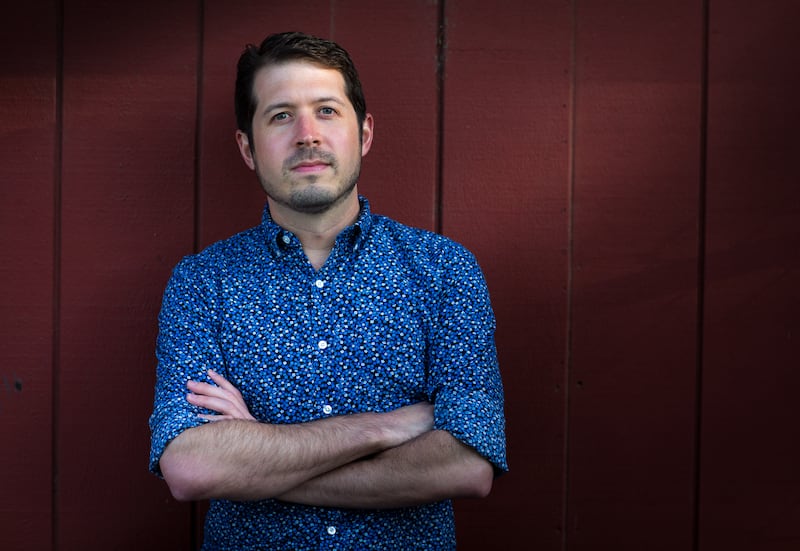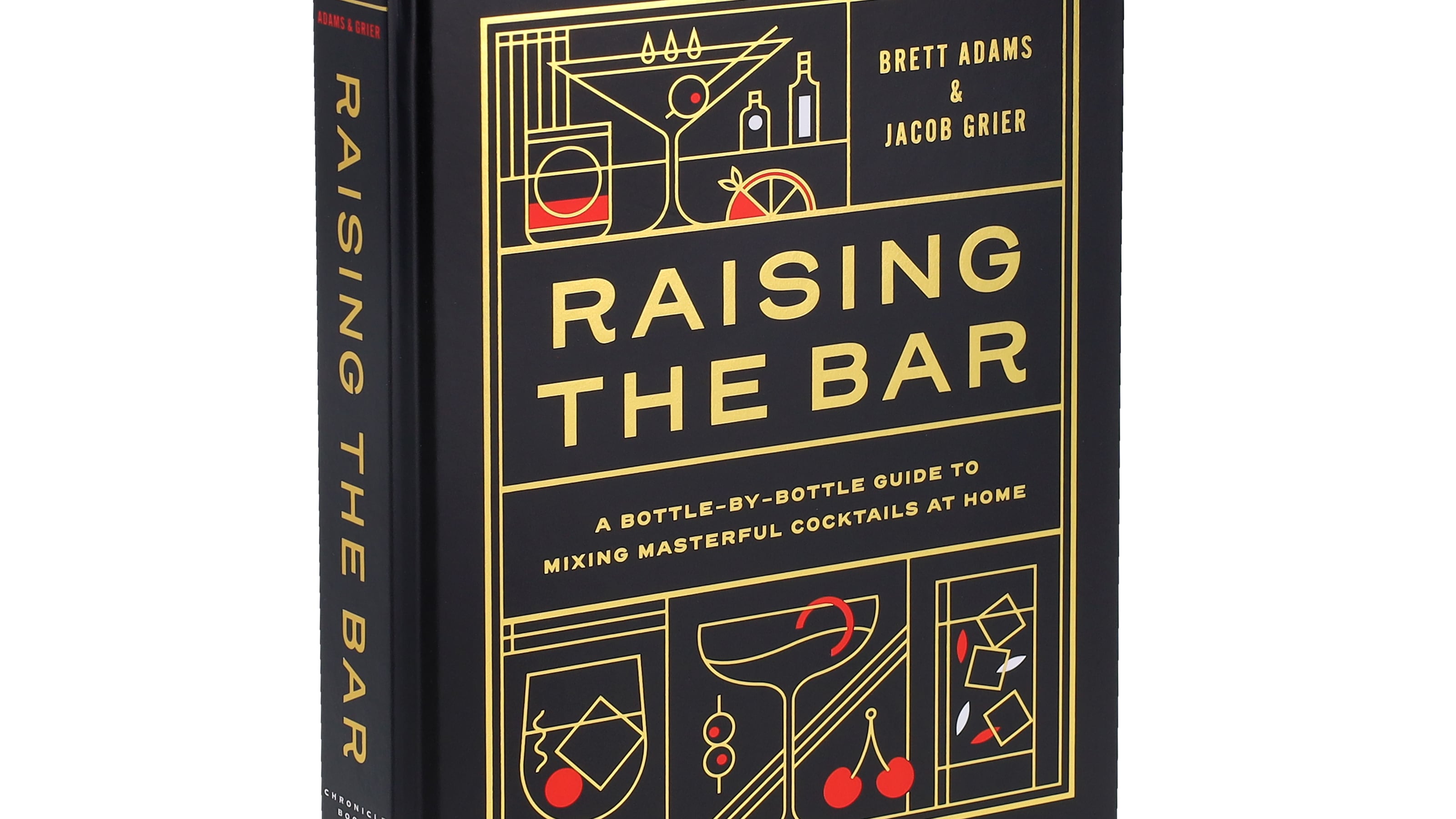When life gave Brett Adams and Jacob Grier lemons, they made whiskey sours. And Corpse Revivers. And sidecars.
After getting laid off from their jobs at the start of the COVID-19 pandemic—Adams, formerly of The Hoxton, was about to take over Submarine Hospitality’s bar program; Grier, a freelance writer and founder of Portland’s Aquavit Week, worked for a Norwegian spirits company—they went to work full time on Raising the Bar: A Bottle-by-Bottle Guide to Mixing Masterful Cocktails at Home (Chronicle Books, 304 pages, $24.95).
The book was already under contract in 2019 and certainly would have been extra timely in 2020. But even if you’ve got a bigger home bar and more cocktail-making experience now than you did then, Raising the Bar will help you go further. The two longtime bartenders, who first met and can still be found at Multnomah Whiskey Library (where Adams is the education manager and spirits curator), have created a primer on what they consider the most essential (and non-arcane) cocktail ingredients. The book’s 233 recipes using 25 different bottles (14 for “the classic bar” and 11 more for “the advanced bar”) progress from the simplest old fashioned or Manhattan to more deeply flavored drinks with maraschino liqueur, absinthe or Cynar (which, as the book explains, are still basically old fashioneds or Manhattans).
We caught up with the authors to ask them about the project’s origins and explain why there are really only three types of cocktails.
WW: So what inspired the book?
Jacob Grier: This mostly came about from frustration. Brett and I both work at the Multnomah Whiskey Library, which has over 2,000 bottles, and we both also have ridiculously big home bars. Yet we would still get modern cocktail books, and we’d be flipping through, and like, even we can’t make these. There’s so much emphasis in high-end cocktail bars on creativity and using the weirdest ingredients or the most cutting-edge techniques. You can kind of lose sight of just how good a simple three- or four-ingredient cocktail can be.

Brett Adams: Which is also the way we bartend at home. Like, I’m about to give a one-hour talk with our team about our new seven-ingredient martini that we’re diluting at 21%. That’s really fun to do in a professional bar. But at home, I don’t make seven-ingredient martinis. I make two-ingredient martinis. So what this book does is talk about how we make cocktails at home and how you can make cocktails at home—taking mostly three- or four-ingredient cocktails and balancing them well and understanding why each component is there.

You make the case that there are only three kinds of cocktails, in terms of the most basic formula: an old fashioned (liquor with sugar and bitters), a Manhattan or martini (liquor with fortified wine), and a sour (liquor with sugar and citrus).
Adams: Exactly. I think that applies to every single one of our cocktails in the book. I’m sure if I put that on Reddit there’ll be a million people arguing over whether or not that’s true, but when you break it down to three cocktails it makes it really simple to understand. “Hey, I’m making a sour cocktail. And when I shake this cocktail, you can connect [that to] a sidecar and a margarita and a white lady and every other cocktail that uses those ingredients.” Simplifying it allows people to understand what they’re using, which then allows them to be more creative in the future.
And you guys aren’t ideologues. There’s a Manhattan with bourbon long before the rye chapter. And you say there’s no right way to make a martini.
Adams: When you dive into the first recipes printed for things like martinis and Manhattans, the dogma goes out the window really quickly. You realize that these are just fundamental beginnings of learning how to mix a spirit and a fortified wine, and that’s all it is. There’s no “it has to be rye,” which is not even listed in the first recipes. All those recipes change over time. The core understanding of a martini and a Manhattan is a spirit and fortified wine, and understanding that balance. Any dogma outside of that is, I think, misunderstanding the point of the cocktail, and just trying to be pretentious. I’m happy to be pretentious, but I want to be a little more informed about my pretensions.
Some readers might find it surprising that after bourbon, gin and vermouth your No. 4 choice was orange liqueur.
Grier: Yeah. We had a couple of reasons for that. Early in the book, we really wanted those fundamental styles: How to stir a cocktail like an old fashioned, how to shake a cocktail like a sour, how to balance a cocktail with vermouth. So that’s the first three chapters out of the way right there. And then the fourth chapter, we wanted to teach you how to balance a cocktail with a liqueur.
The other consideration was, you really need orange liqueur to make classic cocktails with tequila and cognac. We didn’t want to say to someone, “Go out and get a bottle of tequila, but surprise! You can’t make a margarita.” And likewise with cognac in the sidecar. So when you’re stocking your bar, you want to get that orange liqueur. And from that point on, we’re just expanding your bar and making things more fun, more complex and more interesting.
So how are you supposed to not make three cocktails in one night while reading this book?
Grier: Invite friends over! It’s usually more fun than drinking alone anyway.
Adams: One thing that’s not mentioned enough in drinking spaces, for real, is “drink responsibly.” I want people to be able to get this book when they’re 25 and still be making great cocktails from it when they’re 60.
Recipes
These two recipes from Raising the Bar demonstrate Brett Adams and Jacob Grier’s premise that all cocktails are ultimately variations on one of three basic formulas. The Fancy Free, made with bourbon and maraschino liqueur, is an old fashioned in the same genre as The Fancy cocktail (made with orange liqueur) and the Improved Cocktail (made with absinthe), while the gin-based Physically Forgotten falls into the Manhattan/martini category.
Fancy Free
If you recall The Fancy (page 77) and Frisco (page 115) cocktails, you’re hopefully recognizing a trend. Take a slug of whiskey, a small pour of liqueur, and perhaps a dash or two of bitters, and you’ll likely end up with a pretty good drink. The Fancy Free is another testament to the success of this simple formula. A straightforward mixture of bourbon, maraschino liqueur, and a couple dashes of bitters, it’s a drink for those nights when you want an Old-Fashioned with an interesting twist or, if you’re like us, are just out of rich Demerara syrup and can’t be bothered to make more.
Ingredients
- 2 ounces bourbon
- 1/2 ounce maraschino liqueur
- 1 dash Angostura bitters
- 1 dash orange bitters
- Orange peel, for garnish
Directions
To a mixing glass, add the bourbon, maraschino liqueur, both bitters, and ice. Stir and strain into a rocks glass filled with ice or a single large cube. Garnish with an orange peel and serve.
Physically Forgotten
You can never have too many simple, stirred cocktails in your repertoire. When you come home after a long day and you don’t want to be bothered with squeezing citrus or making syrups, a cocktail that can be made with bottles taken right off the shelf is just what you need. The Physically Forgotten from Alise Moffatt, former owner of Portland’s much-missed Shift Drinks bar, fits that profile perfectly. It’s dark, bitter, and quick to whip up, but rich and complex on the palate.
Ingredients
- 1 1/2 ounces gin
- 3/4 ounce Cynar
- 1/2 ounce maraschino liqueur
- 2 dashes orange bitters
- Lemon peel, for garnish
Directions
To a mixing glass, add the gin, Cynar, maraschino liqueur, bitters, and ice. Stir and strain into a chilled coupe glass. Garnish with a lemon peel and serve.
Reprinted from Raising the Bar: A Bottle-by-Bottle Guide to Mixing Masterful Cocktails at Home by Bret Adams and Jacob Grier, with permission by Chronicle Books, 2022.

